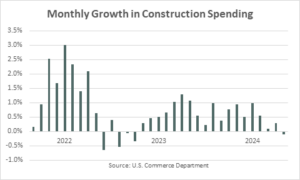by Arsene Aka, Senior Economist at Dodge Construction Network
The U.S. Commerce Department (Census Bureau) recently reported that construction spending stood at a seasonally adjusted annualized rate of $2,139.8 billion in May, representing a 0.1% decline from April’s upwardly revised estimate of $2,142.1 billion. Spending on private construction projects dipped 0.3% during the period to a seasonally adjusted annualized rate of $1,652.1 billion. On the other hand, public construction spending increased 0.5% to $487.6 billion.
Growth in public construction spending continues to be fueled by the Infrastructure Investment and Jobs Act and the CHIPS and Science Act, which earmark hundreds of billions for nonresidential construction verticals such as water and power infrastructure, roads and bridges, and manufacturing. On a year-ago basis, manufacturing construction outlays were up more than 20% in May, while water construction spending increased 13% and spending on highway and street construction jumped 9%.
The monthly decline in private construction spending in May can be attributed to lower outlays on residential construction projects and lower spending on office, health care, education, and religious construction. Outlays on new single-family construction projects fell 0.2%, following a drop in the prior month. On the other hand, new multifamily construction spending was flat in May. Builder confidence continues to worsen, as indicated by the decline of the National Association of Home Builders’ Housing Market Index (HMI) in June to its lowest level of the year. The index is a good gauge of the trend of future single-family home sales and could signal pullback by builders in the coming months.
Year-to-date through May, the total value of construction put in place amounted to $836.3 billion (not seasonally adjusted), about 9% higher than in the same period of 2023. Residential construction outlays were 8% higher in the first five months, while nonresidential construction spending was up 10%. Dodge Construction Network expects robust growth in construction spending over the next two years, driven by higher construction starts, lower interest rates, continued federal funding, and strong economic activity.

